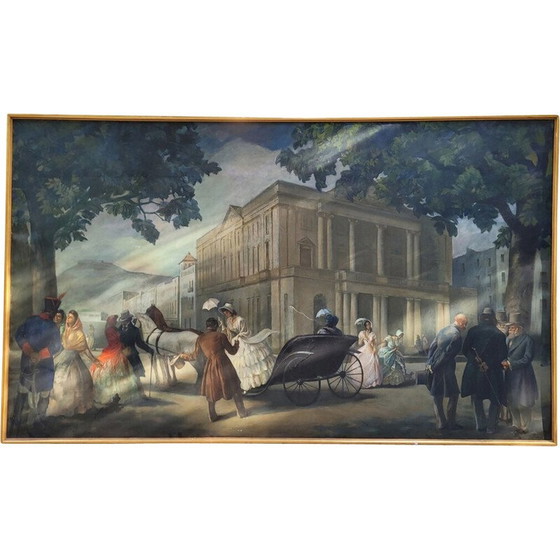Have it delivered hassle-freeBuyer protectionAll items curated by WhoppahDownload the Whoppah app here

Large vintage painting 343cm, daily scene by Lluís Muntané Muns, Spain
Seller: Business seller€5,600Offer from €5,040
Item not as advertised, money backAll items are curated and 100% authenticHave it delivered hassle-free or pick it up yourselfShop only from Trusted Sellers
Business seller
Product description
Large oil on canvas signed by Lluís Muntané Muns depicting a pleasant everyday scene, aristocrats and bourgeois strolling along a grand avenue, the Paseo de Isabel II in Barcelona. The ladies in their elegant dresses and parasols and the men in their long coats.
The composition is divided into a horizontal band in the lower half, in which the various figures are arranged, conversing with each other, flanked by the trees that appear at the ends. Behind them, in the center of the composition, rises a large neoclassical building that juts out into the landscape in the background. This is the Llotja de Barcelona, a building with a neoclassical façade that hides one of the treasures of Catalan civil Gothic inside. It has been the headquarters of emblematic institutions such as the Consulat del Mar, Barcelona's official Chamber of Commerce and the Barcelona Stock Exchange (until 1922).
Lluís Muntané Muns opted for an academic realist style, of high quality but sober, static expression, which also recalls certain features of Catalan noucentisme. Although he devoted most of his career to portraits, he also cultivated muralism. An adept of chiaroscuro, he manages to give warmth to his plastic environments with an equally elegant and restrained palette. His compositions are always well-constructed and possess the elegance that seems to be a dominant note in all aspects of his work.
Noucentisme or Novencentisme refers to a cultural movement born in 1906 in Catalonia (proposed by Eugenio d'Ors), claiming the need for a classicism imbued with modernity, but at the same time linked to tradition, given its nationalist character. Catalan identity is linked to the classical substratum of Catalonia and its connection with the Mediterranean. He wanted to break with the cosmopolitan character of modernism and the ephemeral nature of Impressionism. He sought to achieve a more objective, more constant and, ultimately, more eternal art. To achieve this, he used the idea of the "classical" (but never an explicit copy of that period) and the "Mediterranean", and the way to capture it in painting was through static, balanced and simple compositions. It should be pointed out that this is not a style, but a series of ideas that each artist understands in his or her own way.
In this case, the memory of Noucentisme can be appreciated above all in the composition: a feeling of serenity, proportion, the figures do not present very exaggerated or grandiose movements... He attempts to represent the eternal through balanced composition. The colors seem muted because this effect was sought, as classicism was conceived as something serene and balanced.
Lluís Muntané Muns (Mataró, Barcelona, 1899 - Barcelona, 1987)
A disciple of Vicente Borrás and José Mongrell (from whom he borrowed the use of dramatic light and frequency in the theme of the female figure) at the Barcelona School of Fine Arts, he received a pension from the Diputación Provincial, with which he left for Italy in 1927.
He married Teresa Condeminas, also a painter. Independent by temperament, his style evolved little throughout his career, opting for a high-quality academic realist style, but with a sober, static expression. A lover of dark tones, he succeeded in giving warmth to his plastic environments.
His main subject is the female figure, usually captured in motion. Her attitude is expectant and, on many occasions, she is wrapped in rich clothing, an aspect that accentuates an elegance that is always restrained. An expert portraitist, he painted still lifes, landscapes and religious scenes. He also painted murals. His charcoal portraits testify to his mastery of the drawing technique and, in the field of engraving, his mastery of the series of images he executed around 18th-century Barcelona is particularly remarkable.
Professor of Life Drawing at the Barcelona School of Fine Arts from 1940 to 1969, he headed the institution between 1945 and 1948. Numerous awards and distinctions accompanied the artist's brilliant career, including the National Prize for Painting and Engraving. He took part in art competitions in Barcelona, Madrid, Paris and Buenos Aires. He held his first solo exhibition at Barcelona's Syra galleries in 1930. In 1968, he was named corresponding academician of the Royal Academy of Fine Arts of San Fernando.
The biography was produced by the Royal Academy of History (Lluís Muntané Muns | Royal Academy of History (rah.es)).
Technique: oil on canvas
Title of work: "La marche
Author: Lluís Muntané Muns Lluís Muntané Muns (1899 - 1987)
Style/School: Catalan school
Period: First half of the 20th century
Country of origin: Catalonia, Spain
Origin: Banco Santander boardroom: Banco Santander boardroom
Specifications
ConditionGoodHeight204 cmWidth343 cmDepth6 cm











